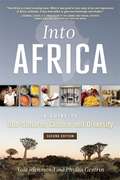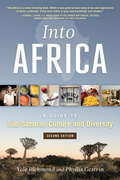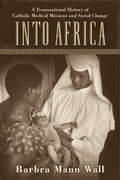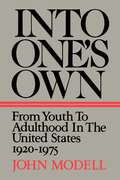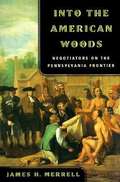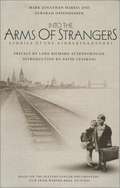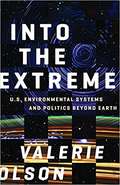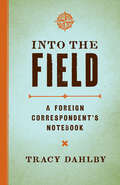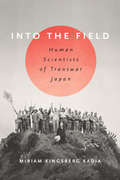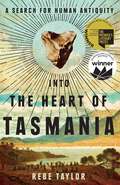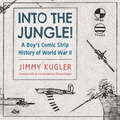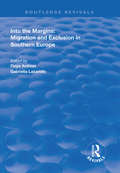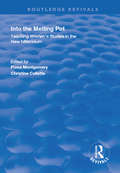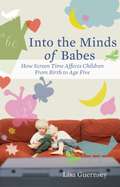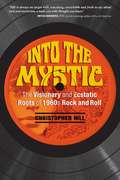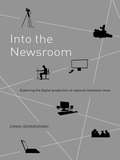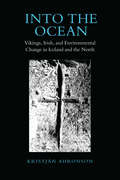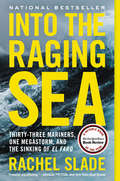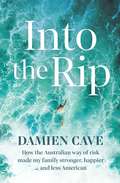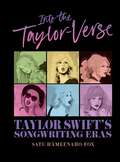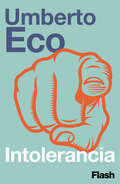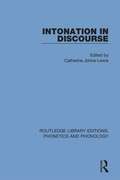- Table View
- List View
Into Africa: A Guide To Sub-saharan Culture And Diversity (Interact Ser.)
by Yale Richmond Phyllis GestrinAcross the globe, Africa is seen as the final frontier for economic development and has experienced renewed attention from both Western and Eastern nations, particularly in the last decade. The U. S. , India, China and parts of Europe have all increased foreign direct investment in Africa, and yet the complexity and diversity of this vast continent pose risks and challenges for those investments. For more than a decade, Into Africa has provided valuable advice to those who are interested in traveling to, living in or working in sub-Saharan Africa'businesspeople, human rights and development workers, diplomats, academics and trainers'and anyone else who seeks a better understanding of the cultural characteristics of this dynamic part of the world. With depth and sensitivity, Into Africa examines the effects of community, ethnicity and language on doing business and establishing professional and personal relationships in African countries. The book explores regional differences, offers detailed guidelines for conducting training programs in Africa and examines issues that reflect the complex relationships involved. This new and expanded edition of Into Africa brings a fresh view on sub-Saharan Africa, showing how the nations of Africa have adapted to Western ways while retaining their cultural traditions and diversity. Authors Yale Richmond and Phyllis Gestrin explore contemporary Africa in great depth, discussing increased trade with the U. S. and Europe, the role of politics and business, changes in mass communication and the continuing threat of HIV/AIDS. A thorough, lively and carefully researched book, Into Africa is the perfect companion for anyone wishing to gain a more rounded perception of Africa and its diverse cultures.
Into Africa: A Guide to Sub-Saharan Culture and Diversity (Interact Ser.)
by Yale RichmondAcross the globe, Africa is seen as the final frontier for economic development and has experienced renewed attention from both Western and Eastern nations, particularly in the last decade. The U.S., India, China and parts of Europe have all increased foreign direct investment in Africa, and yet the complexity and diversity of this vast continent pose risks and challenges for those investments. For more than a decade, Into Africa has provided valuable advice to those who are interested in traveling to, living in or working in sub-Saharan Africa—businesspeople, human rights and development workers, diplomats, academics and trainers—and anyone else who seeks a better understanding of the cultural characteristics of this dynamic part of the world. With depth and sensitivity, Into Africa examines the effects of community, ethnicity and language on doing business and establishing professional and personal relationships in African countries. The book explores regional differences, offers detailed guidelines for conducting training programs in Africa and examines issues that reflect the complex relationships involved. This new and expanded edition of Into Africa brings a fresh view on sub-Saharan Africa, showing how the nations of Africa have adapted to Western ways while retaining their cultural traditions and diversity. Authors Yale Richmond and Phyllis Gestrin explore contemporary Africa in great depth, discussing increased trade with the U.S. and Europe, the role of politics and business, changes in mass communication and the continuing threat of HIV/AIDS. A thorough, lively and carefully researched book, Into Africa is the perfect companion for anyone wishing to gain a more rounded perception of Africa and its diverse cultures.
Into Africa: A Transnational History of Catholic Medical Missions and Social Change
by Professor Barbra Mann WallThe most dramatic growth of Christianity in the late twentieth century has occurred in Africa, where Catholic missions have played major roles. But these missions did more than simply convert Africans. Catholic sisters became heavily involved in the Church's health services and eventually in relief and social justice efforts. In Into Africa, Barbra Mann Wall offers a transnational history that reveals how Catholic medical and nursing sisters established relationships between local and international groups, sparking an exchange of ideas that crossed national, religious, gender, and political boundaries. Both a nurse and a historian, Wall explores this intersection of religion, medicine, gender, race, and politics in sub-Saharan Africa, focusing on the years following World War II, a period when European colonial rule was ending and Africans were building new governments, health care institutions, and education systems. She focuses specifically on hospitals, clinics, and schools of nursing in Ghana and Uganda run by the Medical Mission Sisters of Philadelphia; in Nigeria and Uganda by the Irish Medical Missionaries of Mary; in Tanzania by the Maryknoll Sisters of New York; and in Nigeria by a local Nigerian congregation. Wall shows how, although initially somewhat ethnocentric, the sisters gradually developed a deeper understanding of the diverse populations they served. In the process, their medical and nursing work intersected with critical social, political, and cultural debates that continue in Africa today: debates about the role of women in their local societies, the relationship of women to the nursing and medical professions and to the Catholic Church, the obligations countries have to provide care for their citizens, and the role of women in human rights. A groundbreaking contribution to the study of globalization and medicine, Into Africa highlights the importance of transnational partnerships, using the stories of these nuns to enhance the understanding of medical mission work and global change.
Into One's Own: From Youth to Adulthood in the United States, 1920-1975
by John ModellTracing the life course of American teenagers in the mid-twentieth century, Into One's Own presents a compelling historical portrait of growing up.
Into the American Woods: Negotiators on the Pennsylvania Frontier
by James H. MerrellJames Merrell's brilliant book is an account of the "go-betweens," the Europeans and Indians who moved between cultures on the Pennsylvania frontier in efforts to maintain the peace. It is also a reflection on the meanings of wilderness to the colonists and natives of the New World. From the Quaker colony's founding in the 1680s into the 1750s, Merrell shows us how the go-betweens survived in the woods, dealing with problems of food, travel, lodging, and safety, and how they sought to bridge the vast cultural gaps between the Europeans and the Indians. The futility of these efforts became clear in the sickening plummet into war after 1750.
Into the Arms of Strangers: Stories of the Kindertransport
by Mark Jonathan Harris Deborah OppenheimerBetween December 1938 and the outbreak of war in August 1939, some 10,000 children, the vast majority of them Jews, from Germany, Austria, Poland, and Czechoslovakia were evacuated to Great Britain. The stories of 18 witnesses to this Kindertransport--children, parents, and rescuers--are recounted in Into the Arms of Strangers. These first-person accounts are woven into a loose narrative of life before the Nazi era, the transport, and life in their new homes. The editors wisely remain in the background, allowing the survivor testimony to shine through. Their experiences were diverse: some stayed behind, such as Norbert Wollheim, a Kindertransport organizer who refused a number of chances to escape from Germany, knowing that if he did, the transports would be stopped. Lory Cahn was actually on a train when her father pulled her off; he was unable to let her go. Those who made it to England found challenges of their own: some remained in hostels for the remainder of the war; some were taken in by families to work as cheap servant labor; still others were taken in by loving families, but then had to deal with "survivor's guilt." Years after the war, Vera Gissing asked her foster father why he and his family had taken her in. He answered, "I knew I could not save the world. I knew I could not stop the war from starting. But I knew I could save one human life." Into the Arms of Strangers is a moving tribute to this remarkable event.
Into the Daylight
by Calvin MorrisseauThis book is an account of the personal and collective struggles of First Nations people and how the principles which held traditional societies together can be used today to promote harmonious and cooperative relationships by both aboriginals and non-aboriginals. Calvin Morrisseau provides in it the fundamentals for healing that he has learned over twenty years through his training in counselling and addiction studies; his education in traditional practices by aboriginal elders, healers, and teachers; and his personal recovery from alcoholism, drug addiction, abuse, and the effects of assimilation, racism and poverty.The model of healing Morrisseau advocates is simple, insightful, and based on the values that allowed aboriginal people to live in accord with each other in the past. His approach centres on people accepting responsibility and making choices that give them the freedom required to enter into recovery by recapturing their sense of harmony, cooperation, sharing, balance and spirituality. The deepest healing takes place on a spiritual level. Morrisseau describes an interdependent system of individual, family, and community in which needs, desires, values, and purpose are communicated, and the responsibility to ensure everyone has an opportunity to grow to their full potential is shared. The book is unique in that it offers guidance on ways in which communities can heal.While the book was written for people who work with aboriginal people, the wholistic approach Morrisseau uses can benefit anyone. The healing model can be used by an individual seeking to heal himself, by a professional as a tool for assessment and treatment, and by a community in crisis.
Into the Extreme: U.S. Environmental Systems and Politics beyond Earth
by Valerie OlsonThe first book-length, in-depth ethnography of U.S. human spaceflight What if outer space is not outside the human environment but, rather, defines it? This is the unusual starting point of Valerie Olson&’s Into the Extreme, revealing how outer space contributes to making what counts as the scope and scale of today&’s natural and social environments. With unprecedented access to spaceflight worksites ranging from astronaut training programs to life science labs and architecture studios, Olson examines how U.S. experts work within the solar system as the container of life and as a vast site for new forms of technical and political environmental control. Olson&’s book shifts our attention from space&’s political geography to its political ecology, showing how scientists, physicians, and engineers across North America collaborate to build the conceptual and nuts-and-bolts systems that connect Earth to a specifically ecosystemic cosmos. This cosmos is being redefined as a competitive space for potential economic resources, social relations, and political strategies. Showing how contemporary U.S. environmental power is bound up with the production of national technical and scientific access to outer space, Into the Extreme brings important new insights to our understanding of modern environmental history and politics. At a time when the boundaries of global ecologies and economies extend far below and above Earth&’s surface, Olson&’s new analytic frameworks help us understand how varieties of outlying spaces are known, made, and organized as kinds of environments—whether terrestrial or beyond.
Into the Field: A Foreign Correspondent's Notebook
by Tracy DahlbyTracy Dahlby is an award-winning journalist who has reported internationally as a contributor to National Geographic magazine and served as a staff correspondent for Newsweek and the Washington Post. In this memoir of covering a far-flung swath of Asia, he takes readers behind the scenes to reveal &“the stories behind the stories&”—the legwork and (mis)adventures of a foreign correspondent on a mission to be the eyes and ears of people back home, helping them understand the forces and events that shape our world. Into the Field centers on the travel and reporting Dahlby did for a half-dozen pieces that ran in National Geographic. The book tours the South China Sea during China&’s rise as a global power, visits Japan in a time of national midlife crisis, and explores Southeast Asia during periods of political transition and tumult. Dahlby&’s vivid anecdotes of jousting with hardboiled sea captains, communing with rebellious tribal chieftains, enduring a spectacular shipboard insect attack, and talking his way into a far place or out of a tight spot offer aspiring foreign correspondents a realistic introduction to the challenges of the profession. Along the way, he provides practical advice about everything from successful travel planning to managing headstrong local fixers and dealing with circumstances that can range from friendly to formidable. A knowledgeable, entertaining how-to book for observing the world and making sense of events, Into the Field is a must-read for student journalists and armchair travelers alike.
Into the Field: Human Scientists of Transwar Japan
by Miriam L. Kingsberg KadiaIn the 1930s, a cohort of professional human scientists coalesced around a common and particular understanding of objectivity as the foundation of legitimate knowledge, and of fieldwork as the pathway to objectivity. Into the Field is the first collective biography of this cohort, evocatively described by one contemporary as the men of one age. At the height of imperialism, the men of one age undertook field research in territories under Japanese rule in pursuit of "objective" information that would justify the subjugation of local peoples. After 1945, amid the defeat and dismantling of Japanese sovereignty and under the occupation and tutelage of the United States, they returned to the field to create narratives of human difference that supported the new national values of democracy, capitalism, and peace. The 1968 student movement challenged these values, resulting in an all-encompassing attack on objectivity itself. Nonetheless, the legacy of the men of one age lives on in the disciplines they developed and the beliefs they established about human diversity.
Into the Fire
by Shelley PacholokIn August 2003, one of the largest wildfires in Canadian history struck near Kelowna, British Columbia and the surrounding Okanagan Valley, causing unprecedented damage. As Shelley Pacholok observes in this innovative study, the turbulence and extreme conditions that followed in the wake of this disaster destabilized an important area of social life - that of gender relations.Into the Fire combines insights from gender studies and disaster studies to explore the extent to which notions of "masculinity" and "femininity" are challenged in the wake of crises. Pacholok focuses on how gender relations were simultaneously sustained and disrupted among those who fought the fire, drawing on media representations as well as interviews with firefighters . Into the Fire illuminates how disasters can serve as catalysts for new patterns of gender, even in highly masculine spaces.
Into the Fire: The Fight to Save Fort McMurray
by Graham Hurley Jerron Hawley Steve SackettThe dramatic story of one of the biggest natural disasters in Canadian history, the Fort McMurray wildfire of 2016, told by three of the firefighters who fought to save the city. On May 1, 2016, a wildfire burning to the southwest of Fort McMurray, Alberta, led to the declaration of a local state of emergency. Two days later, the fire had reached Fort McMurray, forcing the evacuation of 88,000 citizens and destroying 2,400 buildings. In total, the fire would consume more than 500,000 hectares. Into the Fire is a remarkable first-hand account of fighting a major wildfire as it moved with terrifying speed. Over the course of six days, firefighters Jerron Hawley, Graham Hurley, and Steve Sackett of the Fort McMurray Fire Department joined local expert wildfire teams and fire departments from across the country to battle the blaze. In photographs and notes made at the time, they vividly describe what they witnessed; their own personal losses and triumphs; and the fire's devastating effects. With more than 90 stunning colour photographs, Into the Fire is a dramatic eyewitness account of one of the most catastrophic disasters in recent North American history. Intimate in its telling, it is above all a testament to the courage, pride, and extraordinary efforts of the citizens of Fort McMurray, who along with emergency personnel, came together to save their city.
Into the Heart of Tasmania: A Search For Human Antiquity
by Rebe TaylorIn 1908 English gentleman, Ernest Westlake, packed a tent, a bicycle and forty tins of food and sailed to Tasmania. On mountains, beaches and in sheep paddocks he collected over 13,000 Aboriginal stone tools. Westlake believed he had found the remnants of an extinct race whose culture was akin to the most ancient Stone Age Europeans. But in the remotest corners of the island Westlake encountered living Indigenous communities.Into the Heart of Tasmania tells a story of discovery and realisation. One man's ambition to rewrite the history of human culture inspires an exploration of the controversy stirred by Tasmanian Aboriginal history. It brings to life how Australian and British national identities have been fashioned by shame and triumph over the supposed destruction of an entire race. To reveal the beating heart of Aboriginal Tasmania is to be confronted with a history that has never ended.
Into the Jungle!: A Boy's Comic Strip History of World War II (Cultures of Childhood)
by Jimmy KuglerNear the end of World War II and after, a small-town Nebraska youth, Jimmy Kugler, drew more than a hundred double-sided sheets of comic strip stories. Over half of these six-panel tales retold the Pacific War as fought by “Frogs” and “Toads,” humanoid creatures brutally committed to a kill-or-be-killed struggle. The history of American youth depends primarily on adult reminiscences of their own childhoods, adult testimony to the lives of youth around them, or surmises based on at best a few creative artifacts. The survival then of such a large collection of adolescent comic strips from America’s small-town Midwest is remarkable. Michael Kugler reproduces the never-before-published comics of his father’s adolescent imagination as a microhistory of American youth in that formative era. Also included in Into the Jungle! A Boy's Comic Strip History of World War II are the likely comic book models for these stories and inspiration from news coverage in newspapers, radio, movies, and newsreels. Kugler emphasizes how US propaganda intended to inspire patriotic support for the war gave this young artist a license for his imagined violence. In a context of progressive American educational reform, these violent comic stories, often in settings modeled on the artist’s small Nebraska town, suggests a form of adolescent rebellion against moral conventions consistent with comic art’s reputation for “outsider” or countercultural expressions. Kugler also argues that these comics provide evidence for the transition in American taste from war stories to the horror comics of the late 1940s and early 1950s. Kugler’s thorough analysis of his father’s adolescent art explains how a small-town boy from the plains distilled the popular culture of his day for an imagined war he could fight on his audacious, even shocking terms.
Into the Margins: Migration and Exclusion in Southern Europe (Routledge Revivals)
by Floya Anthias Gabriella LazaridisFirst published in 1999, this insightful volume thoroughly explores the issue of migration and social exclusion in Southern Europe. It has a number of distinct approaches, including balancing academic research by including the South, reflecting on migration-related policies and a perceptive exploration of the new challenges which face the South. This accessible book will help readers to identify anomalies that lie at the heart of the European Union. On the one hand, unhindered movement of labour is allowed, yet, on the other hand, external frontiers are protected. Borders with Southern Europe allow entry by specific groups of migrants fleeing from their countries (such as the Polish and Albanians who live in Greece) and other illegal migrants. The rationale behind these processes is analysed while keeping in mind societal procedures, such as policy developments, the growth of new forms of xenophobia, exclusion and racialisation of different migrants. Coming at a time when interior ministry officials of the EU member states are pursuing a policy to cut down on third country migrants, this much-needed research sheds light on current political events.
Into the Melting Pot: Teaching Women's Studies into the New Millennium (Routledge Revivals)
by Christine Collette Fiona MontgomeryFrist published in 1997, this collection of essays provides a through discourse on teaching practices in modern day women’s studies. Exploring how women’s studies can further evolve to create a more sustainable pedagogy whilst dealing with the diversity of women’s experiences; such as class, ethnicity class and sexual orientation.
Into the Minds of Babes: How Screen Time Affects Children from Birth to Age Five
by Lisa GuernseyAs a mother, Lisa Guernsey wondered about the influence of television on her two young daughters. As a reporter, she resolved to find out. What she first encountered was tired advice, sensationalized research claims, and a rather draconian mandate from the American Academy of Pediatrics: no TV at all before the age of two. But like many parents, she wanted straight answers and realistic advice, so she kept digging: she visited infant-perception labs and child development centers around the country. She interviewed scores of parents, psychologists, cognitive scientists, and media researchers, as well as programming executives at Noggin, Disney, Nickelodeon, Sesame Workshop, and PBS. Much of what she found flies in the face of conventional wisdom and led her to conclude that new parents will be best served by focusing on “the three C’s”: content, context, and the individual child. Advocating a new approach to television and DVDs, Guernsey focuses on infants to five-year-olds and goes beyond the headlines to explore what exactly is “educational” about educational media. She examines how play and language development are affected by background and foreground television and how to choose videos that are age-appropriate. She explains how to avoid the hype of “brain stimulation” and focus instead on social relationships and the building blocks of language and literacy. Along the way, Guernsey highlights independent research on shows ranging from Dora the Explorer to Dragon Tales, and distills some surprising new findings in the field of child development. Into the Minds of Babesis a fascinating book that points out how little credible research exists to support the AAP’s dire recommendation. Parents, teachers, and psychologists will be relieved to learn positive approaches to using videos with young children and will be empowered to make their own informed choices.
Into the Mystic: The Visionary and Ecstatic Roots of 1960s Rock and Roll
by Christopher HillExplores the visionary, mystical, and ecstatic traditions that influenced the music of the 1960s • Examines the visionary, spiritual, and mystical influences on the Grateful Dead, the Beatles, the Rolling Stones, Bob Dylan, Van Morrison, the Incredible String Band, the Left Banke, Lou Reed and the Velvet Underground, and others • Shows how the British Invasion acted as the “detonator” to explode visionary music into the mainstream • Explains how 1960s rock and roll music transformed consciousness on both the individual and collective levels The 1960s were a time of huge transformation, sustained and amplified by the music of that era: Rock and Roll. During the 19th and 20th centuries visionary and esoteric spiritual traditions influenced first literature, then film. In the 1960s they entered the realm of popular music, catalyzing the ecstatic experiences that empowered a generation. Exploring how 1960s rock and roll music became a school of visionary art, Christopher Hill shows how music raised consciousness on both the individual and collective levels to bring about a transformation of the planet. The author traces how rock and roll rose from the sacred music of the African Diaspora, harnessing its ecstatic power for evoking spiritual experiences through music. He shows how the British Invasion, beginning with the Beatles in the early 1960s, acted as the “detonator” to explode visionary music into the mainstream. He explains how 60s rock and roll made a direct appeal to the imaginations of young people, giving them a larger set of reference points around which to understand life. Exploring the sources 1960s musicians drew upon to evoke the initiatory experience, he reveals the influence of European folk traditions, medieval Troubadours, and a lost American history of ecstatic politics and shows how a revival of the ancient use of psychedelic substances was the strongest agent of change, causing the ecstatic, mythic, and sacred to enter the consciousness of a generation. The author examines the mythic narratives that underscored the work of the Grateful Dead, the French symbolist poets who inspired Bob Dylan, the hallucinatory England of the Beatles’ Sgt. Pepper, the tale of the Rolling Stones and the Lord of Misrule, Van Morrison’s astral journeys, and the dark mysticism of Lou Reed and the Velvet Underground. Evoking the visionary and apocalyptic atmosphere in which the music of the 1960s was received, the author helps each of us to better understand this transformative era and its mystical roots.
Into the Newsroom: Exploring the Digital Production of Regional Television News
by Emma HemmingwayInto the Newsroom provides a rigorous investigation into the everyday rituals that are performed in the television newsroom, and offers a unique suggestion that news is both a highly haphazard and yet technologically complicated process of deliberate construction involving the interweaving of reflexive professional journalists as well as developing, unpredictable technologies. Arguing specifically for a recognition and an exploration of technological agency, this book takes the reader on an exciting journey into the digital newsroom, using exclusive observation and interviews from those journalists working on the BBC's recent pilot project of local television news as part of its empirical evidence. This is an essential introduction for both those seeking to understand news processes at the level of every day routines and practices, and for those students and scholars who are eager to adopt new and challenging ways to theorise news as practice.
Into the Ocean
by Kristjan AhronsonThat Gaelic monasticism flourished in the early medieval period is well established. The "Irish School" penetrated large areas of Europe and contemporary authors describe North Atlantic travels and settlements. Across Scotland and beyond, Celtic-speaking communities spread into the wild and windswept north, marking hundreds of Atlantic settlements with carved and rock-cut sculpture. They were followed in the Viking Age by Scandinavians who dominated the Atlantic waters and settled the Atlantic rim.With Into the Ocean, Kristján Ahronson makes two dramatic claims: that there were people in Iceland almost a century before Viking settlers first arrived c. AD 870, and that there was a tangible relationship between the early Christian "Irish" communities of the Atlantic zone and the Scandinavians who followed them.Ahronson uses archaeological, paleoecological, and literary evidence to support his claims, analysing evidence ranging from pap place names in the Scottish islands to volcanic airfall in Iceland. An interdisciplinary analysis of a subject that has intrigued scholars for generations, Into the Ocean will challenge the assumptions of anyone interested in the Atlantic branch of the Celtic world.
Into the Raging Sea: Thirty-Three Mariners, One Megastorm, and the Sinking of El Faro
by Rachel SladeOn October 1, 2015, Hurricane Joaquin barreled into the Bermuda Triangle and swallowed the container ship El Faro whole, resulting in the worst American shipping disaster in thirty-five years. No one could fathom how a vessel equipped with satellite communications, a sophisticated navigation system, and cutting-edge weather forecasting could suddenly vanish—until now. <p><p> Relying on hundreds of exclusive interviews with family members and maritime experts, as well as the words of the crew members themselves—whose conversations were captured by the ship’s data recorder—journalist Rachel Slade unravels the mystery of the sinking of El Faro. As she recounts the final twenty-four hours onboard, Slade vividly depicts the officers’ anguish and fear as they struggled to carry out Captain Michael Davidson’s increasingly bizarre commands, which, they knew, would steer them straight into the eye of the storm. Taking a hard look at America's aging merchant marine fleet, Slade also reveals the truth about modern shipping—a cut-throat industry plagued by razor-thin profits and ever more violent hurricanes fueled by global warming. <p> A richly reported account of a singular tragedy, Into the Raging Sea takes us into the heart of an age-old American industry, casting new light on the hardworking men and women who paid the ultimate price in the name of profit.
Into the Rip: How the Australian Way of Risk Made My Family Stronger, Happier ... and Less American
by Damien CaveWhen Damien Cave brought his young family to Sydney to set up the New York Times&’ Australian Bureau, they encountered the local pursuits of Nippers and surfing – and a completely different approach to risk that changed the way they lived their lives. Damien Cave has always been fascinated by risk. Having covered the war in Iraq and moved to Mexico City with two babies in nappies, he and his wife Diana thought they understood something about the subject. But when they arrived in Sydney so that Cave could establish The New York Times&’s Australia Bureau, life near the ocean confronted them with new ideas and questions, at odds with their American mindset that risk was a matter of individual choices. Surf-lifesaving and Nippers showed that perhaps it could be managed together, by communities. And instead of being either eliminated or romanticised, it might instead be respected and even embraced. And so Cave set out to understand how our current attitude to risk developed – and why it&’s not necessarily good for us.Into the Rip is partly the story of this New York family learning to live better by living with the sea and it is partly the story of how humans manage the idea of risk. Interviewing experts and everyday heroes, Cave asks critical questions like: Is safety overrated? Why do we miscalculate risk so often and how can we improve? Is it selfish to take risks or can more exposure make for stronger families, citizens and nations? And how do we factor in legitimate fears and major disasters like Cave has covered in his time here: the Black Summer fires; the Christchurch massacre; and, of course, Covid? The result is Grit meets Phosphorescence and Any Ordinary Day – a book that will change the way you and your family think about facing the world&’s hazards. &‘The inspiring, hilarious story of how Damien Cave became a life-saver – only to find that the life he saved was his own.&’ Richard Glover 'It often takes a stranger&’s eyes to see our own country clearly. By plunging into the Sydney surf, Damien Cave peered into the Australian soul. What he found there – courage, grit, community – is welcome news when our lives and our core values have never seemed so precarious.' Geraldine Brooks &‘Into the Rip is a beautiful tale of one family trying to figure things out – and, at the same time, a brilliant synthesis of a century of psychological science on how all of us can learn to dive headfirst into challenges, grow and adapt, and ultimately do well in life.&’ Angela Duckworth, New York Times bestselling author of Grit 'Cave&’s viewfinder – the notion of risk – is perfect for our times.' Malcolm Knox &‘A big-hearted account of a wild and wonderful ride into a new culture and a new way to live.&’ Anna Funder
Into the Taylor-Verse: Taylor Swift's Songwriting Eras
by Satu Hämeenaho-FoxA beautifully illustrated, comprehensive collectible for Swifties everywhere that offers an overview of Taylor Swift&’s life and work, including hidden references for fans to discover in a stunning, giftable package.Into the Taylor-Verse is an inventive, deeply detailed appreciation of Taylor Swift&’s songwriting prowess, her incomparable live performances, and the themes of adolescence and adulthood she&’s detailed so lovingly throughout the different eras of her career from her Fearless to Midnights. This book explores her prolific discography, as well as her worldwide tours, her phoenix-like rise from the ashes to reclaim her music publishing rights, and most importantly of all, her Swifties. In the way that Taylor&’s music helps fans to understand their own emotional response to heartbreak and first love, this book seeks to help fans understand why Taylor&’s music affects them more than any other artist. The story told through her work is the universal story of growing from a girl into a woman, the joy, heartbreak, demoralization, and finally, regrowth and maturity that every fan can relate to no matter their age. This book emulates the joy of Taylor&’s music with creative sidebar content, such as a playlist of her songs that are NOT about boys, an all-important timeline of her hairstyles, biographies of her cats, a deep-dive into the significance of the number thirteen, and so much more. Into the Taylor-Verse is a must-have primer on Taylor for any new Swiftie, telling the stories behind her songs and guiding them to listen more deeply to her extensive back catalogue, while also being a lush examination of the meaning behind the songs that are so important to readers who are already dedicated fans.
Intolerancia
by Umberto EcoEl gran Umberto Eco disecciona la naturaleza incorregible de la intolerancia.«[...] cuando la intolerancia se convierte en doctrina es demasiado tarde para combatirla, y los que deberían hacerlo se convierten en sus primeras víctimas.»Si algo sabe hacer Umberto Eco es hablar con la claridad y la autoridad de los grandes pensadores. En este texto se propone diseccionar sucintamente la esencia de toda intolerancia. Con una evidente lucidez, Eco sitúa el origen de esta lacra en el miedo y el desconocimiento de lo que es diferente. Si algo deja claro es que existe una intolerancia salvaje muy difícil de corregir y que solo educando desde la más temprana infancia es posible intentar erradicarla. Unas pocas palabras de Umberto Eco bastan para que miremos el mundo con ojos nuevos. Críticas:«La figura de Umberto Eco es tanto mayor cuanto más tiempo pasa.»Vicente Verdú, El País«Umberto Eco cambió nuestra mirada sobre los libros: imprescindibles, pequeños, frágiles, a veces criminales, casi siempre salvadores. Un maestro que nos enseñó a entrelazar la sabiduría y el juego con su estilo sagaz y lúdico, con su asombrosa inventiva y certera lucidez.»Irene Vallejo«Un sabio que sabía todas las cosas simulando que las ignoraba para seguir estudiando.»Juan Cruz, El País«La figura de Umberto Eco es tanto mayor cuanto más tiempo pasa.»Vicente Verdú, El País«Laliteratura de Umberto Eco es un bombardeo indiscriminado que no respeta ningún protocolo de guerra.»El Cultural«Umberto Eco disecciona el mal.»La Razón«Un humanista integral.»Fernando Savater«Un genio inagotable, voraz, que construye y deconstruye sin cesar, de inteligencia deslumbrante y humorística cuando hace falta.»Mercedes Monmany, ABC«Uno de los pensadores más influyentes de nuestro tiempo.»Los Angeles Times«Umberto Eco era un hombre libre, dotado de un profundo espíritu crítico y de una gran pasión cívica. [...] Observador agudo y desencantado, sus novelas y ensayos han aportadoprestigioa Italia y ha enriquecido la cultura en todas sus latitudes.»Sergio Mattarella, presidente de la República de Italia«Una de las mentes más brillantes de Italia.»Library Journal
Intonation in Discourse (Routledge Library Editions: Phonetics and Phonology #11)
by Catherine Johns-LewisFirst published in 1986. This book presents studies of intonation undertaken from within a number of different traditions: acoustic phonetics, phonology, psychology, social psychology, syntax, conversation analysis, developmental phonetics and sociolinguistics. The studies reported are empirically based, and give an indication of the many methodologies which have been developed in different disciplines for the investigation of the nature, structure and functions of intonation.
